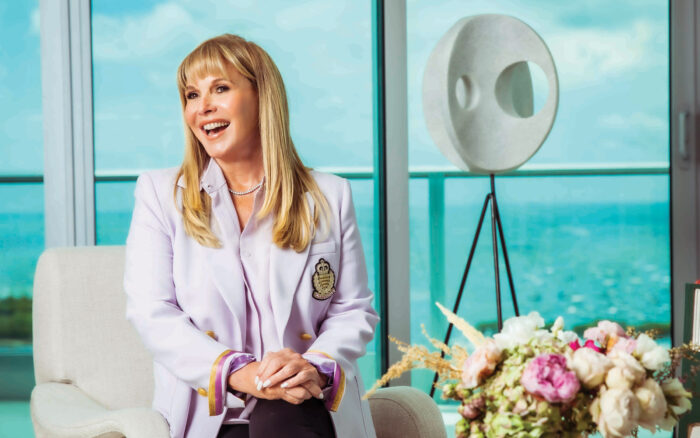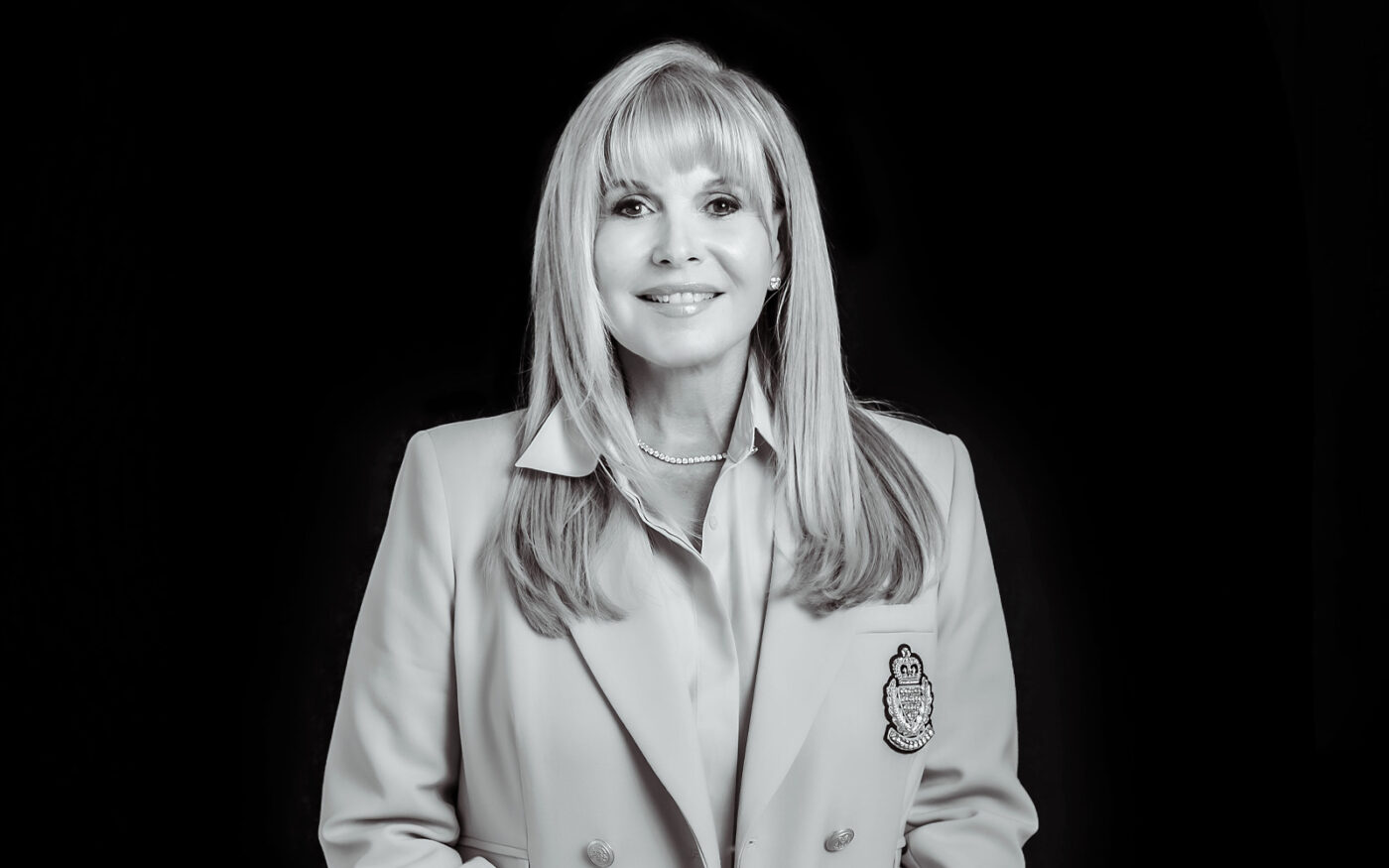“Luxury is not a price point — luxury evokes things in us,” Mayi de la Vega declares. Sure, I counter, but that evocation, in Miami, used to run you about $1,000 a foot. Now, developers can command up to $5,000 a foot for top-shelf product, prices that put Manhattan projects on blast. And de la Vega, as the founder of One Sotheby’s International Realty, has played no small part in that star turn. (Covid, and the subsequent influx of New Yorkers and Californians with different conceptions of what things should cost, helped too.)
A former Coldwell Banker agent who got her start working at her father’s aerospace materials business, de la Vega launched the Sotheby’s franchise in 2008. Today, it has over 1,000 agents across 30 Florida offices; it placed fourth on The Real Deal’s latest ranking of top brokerages in Miami-Dade, with over $2.4 billion in closed deals.
Easy with a laugh and with a taste for zany glasses, de la Vega is less sales-y about describing the overall market than many of her peers. “People can talk about how great things are, and we could do sales for $70 million, $30 million,” she said, “but they’re isolated. Every real estate company is down. Some are down more than others.” Instead, she encourages having the discipline to stick it out and think in cycles.
“It’s about your commitment, just putting blinders on,” she said. “There’s always noise. There’s noise from agents that are saying this is going to fail, this is priced too high, they’re not going to get their loan. You need to move forward with strength, with conviction. You’ve got to do just what you’ve got to do.”
This interview has been edited and condensed for clarity.
Born: December 23, 1959
Hometown: Miami
Lives: Coconut Grove
Family: Engaged, two children (including Daniel de le Vega, One Sotheby’s president)
You were a toddler when your family came to Miami as Cuban refugees.
I remember my mother saying that when we left, she had to sew jewelry inside her bra so that we would have money to survive for the first few months that we were here. My dad was a big fan of the USA, he went to an American school in Cuba. He came here, worked in a factory and then started selling vacuum cleaners. He had an air about him, he was very polished.
Contrast those working-class beginnings with the kind of money you see in the circles you move in today. Do you ever think about those two sides of your life?
All the time. When I’m surrounded by all of that [wealth], I feel immensely grateful and lucky. And at the same time I’m thinking my life could have gone a completely different direction. So I ask myself, what does it take? What is it that propels someone to be able to have that?
What does money mean to you?
It’s a currency. Growing up, there was a lack. What money does for me is give me this stability of knowing that I’m going to be okay. I think we have to be happy with where we got and where we are, but at the same time, always want to continue to achieve and do better. Because how many Chanel bags can you have?
In Miami, it seems like there’s no limit based on the way that people consume.
But does that bring you happiness? Does that bring you peace? I can go and buy Frette linens, but I can [also] go to Crate & Barrel.
“We could do sales for $70 million, $30 million, but they’re isolated.”
What’s your biggest extravagance?
I love art. Because of the culture, because of the people you meet, because it opens up a world of travel. I try to meet the artists that I acquire.
Are you on the circuit? Do you go to the Biennale [Venice] and Art Basel [Switzerland]?
As much as I can. I still work, you know [laughs]. Thank God for virtual working.
Miami has entered an era that perhaps Manhattan was in several years ago, with splashy, show-the-world-who-I-am purchases.
Yes and no. I think there is that component where I want to show you what a big home I have and what I can buy. And then we have clients that make us sign NDAs. I think there’s a movement towards quiet luxury.
At one of your signature projects, One Thousand Museum, there was ugly infighting between the development team and the lenders, the Reuben brothers. How do you, as the broker, navigate that?
It was difficult. We had a lot of bumps along the road. I met with my developers every single week to talk about our marketing strategies and how we would go out there and sell this product to the world. They shared as much as they could with me. And then together we navigated how we would share the messaging with the press, with the sales team, how to keep them motivated. I said, “We have 30 days to get this done. We’re going to deliver what the lender needs and what the developer needs to go to the next stage. We’re not looking back. We’re looking forward, and we’re going to do whatever it takes.”
There were a lot of bumps along the road. But there’s so many bumps in every single development that we don’t even know about. Developers are tough. They always want you to sell, they want you to market. It’s never enough.
Real estate is a tough, sexist industry. But I don’t think it can compare to what you might’ve seen in the airplane business. I’m picturing a 20-something Mayi in some airplane hangar somewhere and a bunch of hard hats around her, whistling.
It taught me to always be a lady and always stand my ground and be nice and friendly, but with boundaries. I love the word boundaries. We need to use boundaries in everything we do.
People can feel your energy. They can feel when you’re walking, if you’re walking in a sexy way to be provocative or you’re walking ’cause you just look good and you just want to get your job done. I was walking through the Pilatus aircraft hangar in Switzerland and thinking, “What am I doing here?” I see the [MeToo] movement, but I think it’s up to us women to give the right signals and the right vibe. And men can read that all day long.

Your son, Daniel, works with you as president of the brokerage. How do you ensure he’s not seen as “the owner’s son”?
I didn’t ensure it. He earned it. With his behavior, with his work ethic, with his decision-making, with the way that he’s able to handle the business.
Within the brokerage business, there was this wave of VC money that wanted growth above all else. That seems to be out, and making a profit is back in. The big trend now is star agents building their own brands who have a lot more leverage than they did 20 years ago.
Without mentioning names, there are new brokerages out there that are really trying to propel the agent forward. But there are certain luxury brands that they will never be able to compete with. They will never be able to have the global referrals or the connectivity. I think brokerage brands will continue to play a role if they pivot, if you give top agents what they want.
But what’s stopping that top agent from saying: “You know what, the Sotheby’s thing, I may not need that, may not need to give up X percent of my commissions for that name anymore.”
There’s a cost to doing business. We all know that the margins have shrunk in brokerage. These agents want more and more. But if they had to pay the PR, the platforms, the social media, the assistants, the marketing directors, the operations directors, when they’re done, they’re going to make a lot less by themselves than they are with us.
When you win back an agent, how do you manage that situation?
Welcome them. Because it really is a testament to how we cater to our agent population. You probably left because you didn’t know how to use some of the tools. You weren’t using everything that you had available. So when they come back, you want to give them more resources and help them succeed.
Miami has historically been a boom ’n’ bust town. This cycle, we’ve already seen developers have to go to Plan B to fill the capital stack. Are they going to be able to build the kind of product they aspired to build 18 months ago?
Some projects will go on pause. Construction costs have risen, land costs have risen, interest rates are higher. The underwriting that they’re looking at is different. And maybe it won’t sell at that price point right now.
You just had the site over in [Downtown Miami] where the developer [Terra’s David Martin] backed out. That was a big one. He probably underwrote it at a certain price. So we might see more of that unfolding.
You dealt with this really ugly embezzlement situation in 2017, where you sued your accountant for taking $1.2 million from your accounts. What did you learn from that?
I am intrinsically a trusting human being. And it was such a shock and such a betrayal that someone that you trusted for so many years could do this to you. I still always want to be that trusting person, but maybe now, I realize that circumstances, and greed, change people.
So I look at things a little more closely now. I also maybe pay my own bills now and not give anybody access to my bank account [laughs].
What’s the best advice you’ve ever received?
Stay grounded and be tolerant of people.
Are you seeing someone at the moment?
I’m with someone right now that’s my life partner, but he’s my fiance. We keep talking about getting married and then we’re like, we might be a little old for that. He also owns a Sotheby’s franchise on the west coast of Florida. I met him at an owners’ event.
What’s the trait you most admire in a person?
Integrity.
What is your biggest regret?
When I was younger, I was investing everything I made back into the business. I wish that I would’ve just bought a ton more real estate.
What’s your idea of a perfect night out?
Just getting caught up on all this reading, taking a magnesium salt bath and laying down on my grounding mat with a great glass of Puligny-Montrachet.
I also love my boat [a 67-foot Ferretti] and anchoring by the Rusty Pelican and looking at the Miami skyline.
A previous version of this story quoted an older total office count from ONE Sotheby’s website. The brokerage now has 30 offices.

